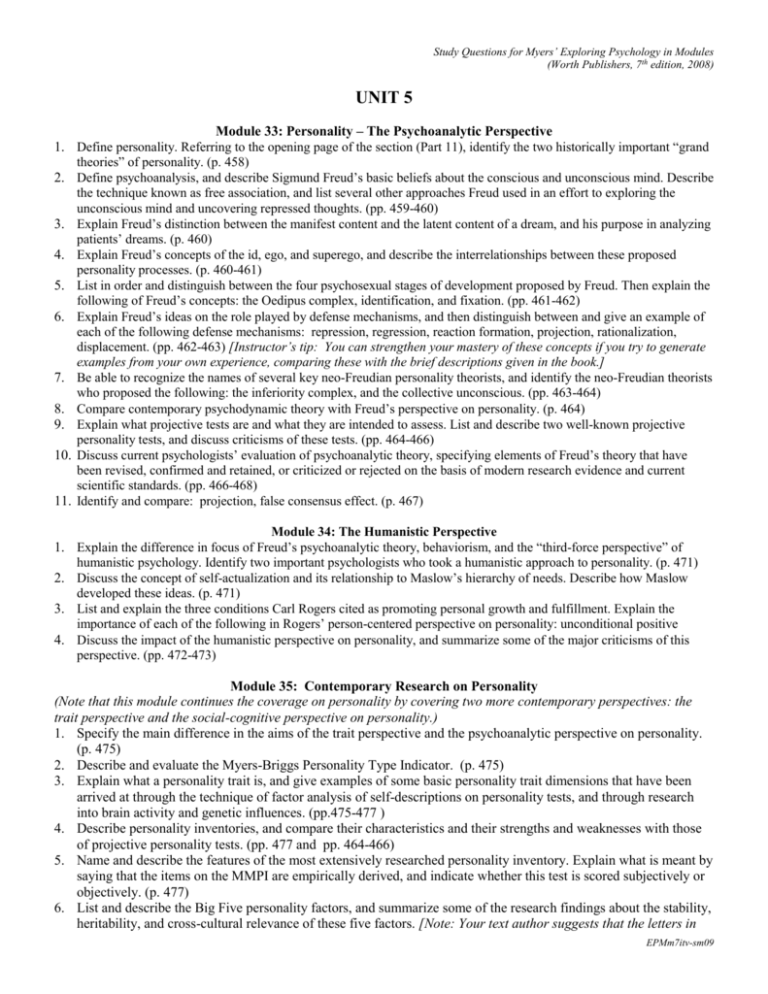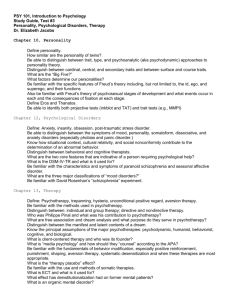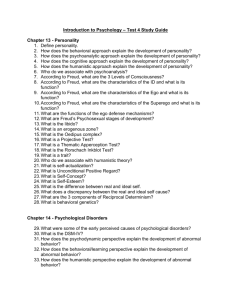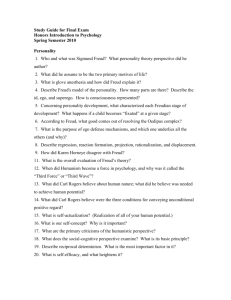Chapter 1
advertisement

Study Questions for Myers’ Exploring Psychology in Modules (Worth Publishers, 7th edition, 2008) UNIT 5 Module 33: Personality – The Psychoanalytic Perspective 1. Define personality. Referring to the opening page of the section (Part 11), identify the two historically important “grand theories” of personality. (p. 458) 2. Define psychoanalysis, and describe Sigmund Freud’s basic beliefs about the conscious and unconscious mind. Describe the technique known as free association, and list several other approaches Freud used in an effort to exploring the unconscious mind and uncovering repressed thoughts. (pp. 459-460) 3. Explain Freud’s distinction between the manifest content and the latent content of a dream, and his purpose in analyzing patients’ dreams. (p. 460) 4. Explain Freud’s concepts of the id, ego, and superego, and describe the interrelationships between these proposed personality processes. (p. 460-461) 5. List in order and distinguish between the four psychosexual stages of development proposed by Freud. Then explain the following of Freud’s concepts: the Oedipus complex, identification, and fixation. (pp. 461-462) 6. Explain Freud’s ideas on the role played by defense mechanisms, and then distinguish between and give an example of each of the following defense mechanisms: repression, regression, reaction formation, projection, rationalization, displacement. (pp. 462-463) [Instructor’s tip: You can strengthen your mastery of these concepts if you try to generate examples from your own experience, comparing these with the brief descriptions given in the book.] 7. Be able to recognize the names of several key neo-Freudian personality theorists, and identify the neo-Freudian theorists who proposed the following: the inferiority complex, and the collective unconscious. (pp. 463-464) 8. Compare contemporary psychodynamic theory with Freud’s perspective on personality. (p. 464) 9. Explain what projective tests are and what they are intended to assess. List and describe two well-known projective personality tests, and discuss criticisms of these tests. (pp. 464-466) 10. Discuss current psychologists’ evaluation of psychoanalytic theory, specifying elements of Freud’s theory that have been revised, confirmed and retained, or criticized or rejected on the basis of modern research evidence and current scientific standards. (pp. 466-468) 11. Identify and compare: projection, false consensus effect. (p. 467) Module 34: The Humanistic Perspective 1. Explain the difference in focus of Freud’s psychoanalytic theory, behaviorism, and the “third-force perspective” of humanistic psychology. Identify two important psychologists who took a humanistic approach to personality. (p. 471) 2. Discuss the concept of self-actualization and its relationship to Maslow’s hierarchy of needs. Describe how Maslow developed these ideas. (p. 471) 3. List and explain the three conditions Carl Rogers cited as promoting personal growth and fulfillment. Explain the importance of each of the following in Rogers’ person-centered perspective on personality: unconditional positive 4. Discuss the impact of the humanistic perspective on personality, and summarize some of the major criticisms of this perspective. (pp. 472-473) Module 35: Contemporary Research on Personality (Note that this module continues the coverage on personality by covering two more contemporary perspectives: the trait perspective and the social-cognitive perspective on personality.) 1. Specify the main difference in the aims of the trait perspective and the psychoanalytic perspective on personality. (p. 475) 2. Describe and evaluate the Myers-Briggs Personality Type Indicator. (p. 475) 3. Explain what a personality trait is, and give examples of some basic personality trait dimensions that have been arrived at through the technique of factor analysis of self-descriptions on personality tests, and through research into brain activity and genetic influences. (pp.475-477 ) 4. Describe personality inventories, and compare their characteristics and their strengths and weaknesses with those of projective personality tests. (pp. 477 and pp. 464-466) 5. Name and describe the features of the most extensively researched personality inventory. Explain what is meant by saying that the items on the MMPI are empirically derived, and indicate whether this test is scored subjectively or objectively. (p. 477) 6. List and describe the Big Five personality factors, and summarize some of the research findings about the stability, heritability, and cross-cultural relevance of these five factors. [Note: Your text author suggests that the letters in EPMm7itv-sm09 Study Questions for Myers’ Exploring Psychology in Modules (Worth Publishers, 7th edition, 2008) 7. 8. 9. 10. 11. 12. 13. 14. 15. 16. the word “CANOE” will help you to remember the first letter of each of the Big Five factors; another option is to remember the word “OCEAN” as a cue for the list.] (pp. 477-478) Explain the person-situation controversy. Describe what research has revealed about the consistency of certain personality characteristics across various situations and over time, and about the ability of personality tests to predict behavior. (pp.478-479, and 482-483 ) Summarize the findings from research exploring whether astrology and graphology can provide valid assessments of personality. Then explain some the reasons why people often perceive astrologers’ personality descriptions to be valid (including the “Barnum effect”). (pp. 480-481) Explain the major points of emphasis in Bandura’s social-cognitive perspective on personality. List the three mutually interacting elements involved in reciprocal determinism, and give an example that illustrates this concept. (pp. 483-484 and Figure 35.3) Compare and contrast internal and external locus of control, and review research evidence from correlational research and experiments on the effects of personal control versus learned helplessness. (pp. 485-486) Discuss the relationship between optimistic or pessimistic attributional style and motivation, mood, performance, and health. (pp. 486-488) Compare and contrast positive psychology and humanistic psychology. (p. 487) Define and give examples of the following: possible selves, spotlight effect. (pp. 490-491) Discuss some of the characteristics associated with high self-esteem, and present two alternative interpretations of the correlation between low self-esteem and problems in life. Describe how members of stigmatized or low-status groups have maintained their self-esteem. (pp. 695-696) Summarize several lines of evidence illustrating the tendency to maintain self-esteem through a self-serving bias. (pp. 492-494) Distinguish between defensive self-esteem and secure self-esteem. (p.494) Module 36: Introduction to Psychological Disorders 1. After reading the page introducing Modules 36-39, list the major categories of psychological disorders covered in these modules. (p. 498) 2. List the defining criteria for a psychological disorder, and discuss some of the issues and controversies related to the labeling of behavior as disordered. (pp. 499-500) 3. Describe and distinguish between the medical model and the biopsychosocial approach to behavior disorders. (pp. 500, 502) 4. Define ADHD, and discuss some of the controversies over its diagnosis and treatment. (p. 501) 5. Describe the DSM-IV, clarifying its purpose and characteristics, and indicating whether the DSM explains causes of disorders and recommends treatments for them or simply describes and classifies disorders. (pp. 502-503 6. Discuss some of the advantages and drawbacks of diagnostic labeling. (pp. 503-505) 7. Indicate whether most people with psychological disorders are prone to violence. Cite statistics on the percentage of jail and prison inmates who have severe psychiatric disorders. (p. 505) 8. Cite statistics on how common psychological disorders are in the overall U.S. population, and discuss the question of whether poverty causes psychological disorders. (pp. 506-507) Module 37: Anxiety, Dissociative, and Personality Disorders 1. Describe the main symptoms of the anxiety disorders, differentiate between ordinary anxiety and pathological anxiety, and list the five types off anxiety disorders discussed in this module. (p. 509) 2. Describe and distinguish between generalized anxiety disorder and panic disorder. (pp. 509-51) 3. Explain what a phobia is. List a few common phobias, tell how phobias differ from more ordinary fears, and distinguish between specific phobias, social phobia, and agoraphobia. (pp. 510-511 and Figure 37.1) 4. Describe obsessive-compulsive disorder (OCD). Distinguish between obsessions and compulsions, and then list some common varieties of obsessions and compulsions. (p. 511, including Table 37.1) 5. Explain what can trigger the occurrence of post-traumatic stress disorder, and describe the symptoms of PTSD. (pp. 511-512) 6. Summarize explanations of anxiety disorders offered from the learning perspective and the biological perspective in psychology. (pp. 513-514) 7. Describe dissociative identity disorder (DID), and discuss some of the questions raised about this diagnosis. (pp. 515-517) EPMm7itv-sm09 Study Questions for Myers’ Exploring Psychology in Modules (Worth Publishers, 7th edition, 2008) 8. Describe personality disorders, and be able to recognize examples. Then identify the term used to refer to the personalities of people formerly labeled as “psychopaths” or “sociopaths,” and describe the behavior associated with this personality disorder. Discuss evidence on the contribution of biological and sociocultural factors to antisocial personality disorder. (pp. 517-518) Module 38: Mood Disorders 1. Describe and distinguish between: major depressive disorder, seasonal affective disorder mania, and bipolar disorder. (pp. 521-522) [Note: Seasonal affective disorder is described in the margin of page 521, and also discussed along with light exposure therapy in Module 41, pp. 558-589], , 2. Review some basic facts about depression, including its prevalence and its association with gender and stressful events. (pp. 521-524) 3. List specific points of evidence supporting the idea that the development of mood disorders may be related to genetics and brain chemistry. (pp. 524-526) 4. Compare the frequency of suicide attempts and death by suicide for men and women, and for older versus younger people. and describe the link between suicide and alcohol and drug abuse. (pp. 524-525) 5. Discuss what social-cognitive psychologists have discovered about the types of thought patterns (including the specific components of a pessimistic explanatory style) that are related to negative moods. (pp. 526-528, and Figure 38.4) 6. Review the biopsychosocial approach to depression. (p. 529, Figure 38.6) 1. 2. 3. 4. 5. 6. 7. 8. 9. Module 39: Schizophrenia Distinguish between schizophrenia and “multiple personality,” and list and describe some of the prominent symptoms of schizophrenia. (pp. 531-533) Identify and distinguish between the following: a) positive symptoms and negative symptoms of schizophrenia; b) hallucinations and delusions (including paranoid delusions or delusions of persecution); c) flat affect and inappropriate affect. (pp. 531-533) Summarize statistics on the proportion of the population who will develop schizophrenia. Compare its impact on the male and female population, and indicate the developmental period during which it is usually first diagnosed. (p. 532) Distinguish between paranoid tendencies and catatonia schizophrenia, and between chronic and acute schizophrenia. (p. 531-533) List and explain some of the abnormalities in brain chemistry, brain activity, and brain anatomy that researchers have identified in people with schizophrenia. Discuss how drugs that reduce symptoms of schizophrenia affect brain chemistry. (pp. 533-534) Identify several suspected prenatal risk factors for schizophrenia. Summarize evidence suggesting that prenatal viruses may affect the risk for schizophrenia later in life. (pp. 534535) Summarize the evidence suggesting that genetic factors contribute to the development of schizophrenia. (pp. 535536) Explain current thinking on the question of whether family influences (such “refrigerator mothers”) appear to cause schizophrenia. (pp. 536-537) Module 40: Therapy – The Psychological Therapies 1. Distinguish between psychotherapy and the biomedical therapies, and describe the eclectic approach to therapy. (pp. 540-541) 2. Describe the assumptions and aims of traditional psychoanalysis, and explain its basic techniques. Identify and discuss the role of each of the following in psychoanalysis: free association, resistance, interpretation, latent content of dreams, and transference in psychoanalysis. (pp. 541-542). 3. Identify some of the criticisms of traditional psychoanalysis. (p. 542) 4. Compare and contrast psychodynamic therapy, interpersonal therapy, and traditional psychoanalysis. (pp. 542-543) 5. Compare and contrast humanistic therapies and psychoanalysis. Describe the goals and techniques of Carl Rogers’ client-centered therapy. Discuss the characteristics exhibited by effective therapists, according to Rogers. Also explain the importance of active listening techniques and unconditional positive regard in this form of therapy. (pp. 543-545) EPMm7itv-sm09 Study Questions for Myers’ Exploring Psychology in Modules (Worth Publishers, 7th edition, 2008) 6. Specify how the assumptions and techniques of behavior therapy differ from those of psychoanalysis and humanistic therapy. (p. 545) 7. Explain and give examples of several behavior therapy techniques based on classical conditioning principles, including: a) exposure therapies, such as systematic desensitization and virtual reality exposure therapy; and b) aversive conditioning. (pp. 545-547) 8. Summarize the fundamental idea of operant conditioning. Then describe examples of behavior modification based on operant conditioning principles, and explain what a token economy is. (p. 548) 9. Explain the assumptions and techniques of cognitive therapy and cognitive-behavior therapy. Summarize what research has revealed about the effectiveness of these methods of therapy: a) in treating and preventing depression, and b) in reducing symptoms of obsessive-compulsive behavior. (pp. 548-551, including Figure 40.2) 10. Describe some of the advantages of group therapy, as compared with individual therapy. (p. 551) 11. Identify the assumptions and goals of family therapy. (p. 551) Module 41: Evaluating Psychotherapies 1. Explain why it is so important to evaluate the effectiveness of psychotherapy through randomized clinical trials, rather than relying entirely on the perceptions of clients and/or clinicians. Describe the procedures involved in randomized clinical trials. (pp. 554-555) 2. Provide an overview of the results of outcome research investigating whether psychotherapy is actually effective in general, and whether its cost is justified. (p. 556) 3. Summarize results of recent research studies exploring whether particular kinds of psychotherapy are best for treating specific psychological disorders. (p. 557) 4. Explain why certain entirely unproven alternative therapies often become popular. Describe claims that have been made about the following alternative therapies, and then summarize what research results suggest about their effectiveness: a) EMDR, and b) light therapy, also identifying the types of disorders for which these alternative therapies been used. (pp. 558-559) 5. Describe and discuss some commonalities among therapies that may contribute to their effectiveness. (pp. 559561) 6. Distinguish between the academic degrees and the areas of expertise of: a) clinical or psychiatric social workers, b) clinical psychologists, and c) psychiatrists. (p. 560, Table 41.1) 7. Identify and discuss the importance of the following: therapeutic alliance, paraprofessionals (pp. 560-561). Module 42: The Biomedical Therapies 1. List several types of biomedical therapy, and specify which type is most widely used today. (p. 565) 2. Compare statistics on the number of U.S. mental hospital residents in the mid-1950s with more recent numbers, and explain some of the reasons for this change. (p. 565) 3. Identify the placebo effect and the double-blind technique, explaining why double-blind studies are so important in evaluating the effectiveness of drug therapy. (p. 565) 4. List the names of several antipsychotic drugs, mentioning the condition for which they are most often prescribed and describing in a general way how they work. Compare the side effects of the earlier antipsychotic drugs and the new-generation antipsychotic drugs. (p. 566) 5. Describe the symptoms and causes of tardive dyskinesia, and specify which antipsychotic medications carry the greatest risk for this side effect. (p. 566) 6. Explain how antianxiety drugs work, noting their potential dangers and drawbacks. (p. 566) 7. Discuss antidepressant medications, describing how they work. Explain what SSRI drugs are, give examples, and discuss controversial issues related to the use of these medications to treat depression. (pp. 566-568) 8. Discuss the use of lithium in the treatment of mood disorder, and summarize evidence that lithium is effective in stabilizing mood. (p. 568) 9. Describe electroconvulsive therapy (ECT), and explain what research has shown about its effectiveness. Compare the effects on the brain of ECT and rTMS. (pp. 568-569) 10. Define psychosurgery, and trace the history of the psychosurgical procedure known as lobotomy. (pp. 570-571) 11. Discuss the importance of a perspective on psychotherapy that considers mind and body as a unit, and relate this view to the biopsychosocial theme emphasized by the author throughout your textbook. (p. 575) EPMm7itv-sm09








